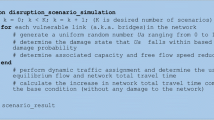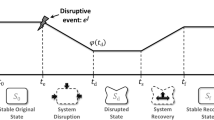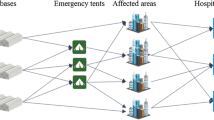Abstract
Destruction of the roads and disruption in transportation networks are the aftermath of natural disasters, particularly if they are of great magnitude. As a version of the network capacity reliability problem, this work researches a post-disaster transportation network, where the reliability and operational capacity of links are uncertain. Uncertainty theory is utilized to develop a model of and solve the uncertain maximum capacity path (UMCP) problem to ensure that the maximum amount of relief materials and rescue vehicles arrive at areas impacted by the disaster. We originally present two new problems of \(\alpha\)-maximum capacity path (\(\alpha\)-MCP), which aims to determine paths of highest capacity under a given confidence level \( \alpha\), and most maximum capacity path (MMCP), where the objective is to maximize the confidence level under a given threshold of capacity value. We utilize these auxiliary programming models to explicate the method to, in an uncertain network, achieve the uncertainty distribution of the MCP value. A novel approach is additionally suggested to confront, in the framework of uncertainty programming, the stability analysis problem. We explicitly enunciate the method of computing the links’ tolerances in \({\mathcal{O}}\left( m \right)\) time or \({\mathcal{O}}\left( {\left| {P^{*} } \right|m} \right)\) time (where \(m\) indicates the number of links in the network and \(\left| {{\text{P}}^{*} } \right|\) the number of links on the given MCP \({\text{P}}^{*}\)). After all, the practical performance of the method and optimization model is illustrated by adopting two network samples from a real case study to show how our approach works in realistic contexts.







Similar content being viewed by others
Availability of data and material (data transparency)
A large body of sample data come from quantitative and topological analyses, OpenStreetMap and Google Map databases (available for research at no cost), which were used for the street data of Gävle and the boundary of the city. Part of the data we gathered come from source documents analysis and qualitative and quantitative analyses, such as experts' empirical data, individual semi-structured interviews, expertbased opinions, conceptual documents, and expert analyses. It has to be stated that at this stage of research the transcripts and documents are available in Swedish.
References
Ahuja, R. K., Magnanti, T. L., & Orlin J. B. (1993). Network flows: Theory, algorithms, and applications. Prentice Hall.
Aydin, N. Y., Duzgun, H., Heinimann, H. R., Wenzel, F., & Gnyawali, K. R. (2018). Framework for improving the resilience and recovery of transportation networks under geohazard risks. International Journal of Disaster Risk Reduction, 31, 832–843.
Chang, S., & Nojima, N. (2001). Measuring post-disaster transportation system performance: The 1995 kobe earthquake in comparative perspective. Transportation Research Part A: Policy and Practice, 35(6), 475–494.
Chen, A., Yang, H., Lo, H., & Tang, W. (1999). A capacity related reliability for transportation networks. Journal of Advanced Transportation, 33(2), 183–200.
Frank, H. (1969). Shortest paths in probabilistic graphs. Operations Research, 17(4), 583–599.
Gao, Y. (2012). Uncertain inference control for balancing an inverted pendulum. Fuzzy Optimization and Decision Making, 11(4), 481–492.
Hosseini, A. (2015). Time-dependent optimization of a multi-item uncertain supply chain network: A hybrid approximation algorithm. Discrete Optimization, 18, 150–167.
Hosseini, A., & Wadbro, E. (2016). Connectivity reliability in uncertain networks with stability analysis. Expert Systems with Applications, 57, 337–344.
Jiang, B. (2012). Axwoman 6.0: An ArcGIS extension for urban morphological analysis, http://fromto.hig.se/~bjg/Axwoman.htm. University of Gävle.
Kuang, A., Tang, Z., & Shan, L. (2013). Road network capacity reliability considering travel time reliability. Procedia-Social and Behavioral Sciences, 96, 1818–1827.
Liu, B. (2021). Uncertainty theory, 5th edn. Uncertainty Theory Laboratory.
Liu, B. (2010). Uncertainty Theory: A Branch of mathematics for modeling human uncertainty. Springer.
Liu, Y. (2013). Uncertain random programming with applications. Fuzzy Optimization and Decision Making, 12(2), 153–169.
Mishra, S., Welch, T., Torrens, P., Fu, C., Zhu, H., & Knapp, E. (2015). A tool for measuring and visualizing connectivity of transit stop, route and transfer center in a multimodal transportation network. Public Transport, 7(1), 77–99.
Psaltoglou, A., & Calle, E. (2018). Enhanced connectivity index—A new measure for identifying critical points in urban public transportation networks. International Journal of Critical Infrastructure Protection, 21, 22–32.
Qin, J., Ye, Y., Shen, C., Zhang, W., & Hong, J. (2018). Optimization method for emergency resource layout for transportation network considering service reliability. Journal of Railway Science and Engineering, 15(2), 506–514.
Qing, C., & Yuhong, S. (2012). Uncertain programming model for solid transportation problem. Information, 15(12), 342–348.
Sen, S., Pillai, R., Joshi, S., & Rathi, A. (2001). A mean-variance model for route guidance in advanced traveler information systems. Transportation Science, 35(1), 37–49.
Seshadri, R., & Srinivasan, K. (2012). An algorithm for the minimum robust cost path on networks with random and correlated link travel times. In Network reliability in practice (pp. 171–208). Springer.
Sun, X. (2012). An urban morphological study on Swedish cities from a topological perspective, University of Gävle.
Wang, G., Zeng, Q., Li, K., & Yang, J. (2016). Port connectivity in a logistic network: The case of Bohai Bay, China. Transportation Research Part E: Logistics and Transportation Review, 95, 341–354.
Xiao, L., & Lo, H. (2013). Adaptive vehicle routing for risk-averse travelers. Procedia-Social and Behavioral Sciences, 80, 633–657.
Xing, T., & Zhou, X. (2011). Finding the most reliable path with and without link travel time correlation: A Lagrangian substitution based approach. Transportation Research Part B: Methodological, 45, 1660–1689.
Zhang, X., Zhong, Q., & Luo, Q. (2019). Evaluation of transportation network reliability under emergency based on reserve capacity. Journal of Advanced Transportation.
Zhu, Z., Zhang, A., & Zhang, Y. (2018). Connectivity of intercity passenger transportation in china: A multi-modal and network approach. Journal of Transport Geography, 71, 263–276.
Funding
No funding was received to assist with the preparation of this manuscript.
Author information
Authors and Affiliations
Contributions
Ahmad Hosseini: Methodology, Conceptualization, Writing- Original draft preparation, Investigation, Writing- Reviewing and Editing, Formal analysis. Mir Saman Pishvaee: Project Administration, Supervision, Validation.
Corresponding author
Ethics declarations
Conflict of interest
We wish to confirm that there are no known competing financial interests or personal relationships that could have appeared to influence the work reported in this paper, and there has been no significant financial support (other than those mentioned in Acknowledgment in the paper) for this work that could have influenced its outcome.
Consent to participate (include appropriate statements)
The authors have consented to the submission of the paper for submission to the journal.
Consent for publication (include appropriate statements)
The authors declare that they have consented to the submission and publication of the paper.
Ethical approval
We confirm that the manuscript has been read and approved by all named authors and that there are no other persons who satisfied the criteria for authorship but are not listed. We further confirm that the order of authors listed in the manuscript has been approved by all of us. We confirm that we have given due consideration to the protection of intellectual property associated with this work and that there are no impediments to publication, including the timing of publication, with respect to intellectual property. In so doing we confirm that we have followed the regulations of our institutions concerning intellectual property.
Additional information
Publisher's Note
Springer Nature remains neutral with regard to jurisdictional claims in published maps and institutional affiliations.
Rights and permissions
About this article
Cite this article
Hosseini, A., Pishvaee, M.S. Capacity reliability under uncertainty in transportation networks: an optimization framework and stability assessment methodology. Fuzzy Optim Decis Making 21, 479–512 (2022). https://doi.org/10.1007/s10700-021-09374-9
Accepted:
Published:
Issue Date:
DOI: https://doi.org/10.1007/s10700-021-09374-9




